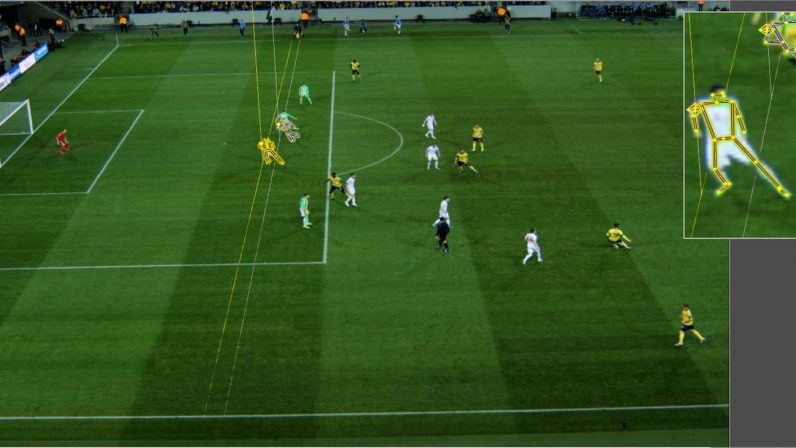The offside rule is one of the most controversial and complex laws of soccer. Due to the many factors involved, it’s hard to judge an offside call accurately for referees in a blink of a second.
<iframe srcdoc="*{padding:0;margin:0;overflow:hidden}html,body{background:#000;height:100%}img{position:absolute;top:0;left:0;width:100%;height:100%;object-fit:cover;transition:opacity .1s cubic-bezier(0.4,0,1,1)}a:hover img+img{opacity:1!important}

 ” height=”240″ width=”320″ allow=”accelerometer; autoplay; clipboard-write; encrypted-media; gyroscope; picture-in-picture” allowfullscreen frameborder=”0″>[embedded content]
” height=”240″ width=”320″ allow=”accelerometer; autoplay; clipboard-write; encrypted-media; gyroscope; picture-in-picture” allowfullscreen frameborder=”0″>[embedded content]
That’s why FIFA, soccer’s governing body, other associations introduced an official position called the Video Assistant Referee (VAR) to review game-changing moments with the help of footage. These included potential penalties, red-cards, and offside offenses.
While penalty and red card calls are largely subjective — even when they are being checked by VAR — offside is an objective call that can be measured using players’ relative position and kick-point of the ball (when the ball was released by a player). So now, AI is getting involved to help decide the course of major matches by calling offside more accurately.
Till now, VARs have been checking offside calls manually, with only a few organizations such as the English Premier League showing the offside line to viewers at home. When there are close calls, referees need to manually check the offside line to see if the player’s limbs are crossing it.
The problem is sometimes these decisions can take a long time. In a recent match between AS Roma and FC Torino in the Italian Serie A, VAR took more than five minutes to pass the verdict. This breaks the flow of the game, and it can be frustrating for both fans and players.
This Roma offside is very funny. It took VAR 5 MINS 10 seconds To arrive at a conclusion.
Shouldn’t it tell any sane referee this is clearly not an obvious offside.
How can Tammy be ahead of the defender and at the same time behind, by just a millimeter.😂
— Jonathan Forgor (@ForgorJonathan) November 28, 2021
To solve this problem, FIFA has decided to take the help of AI and software to make the process of offside reviews quicker.
FIFA experimented with this tech last year, and now it plans to use it in the upcoming Arab Cup 2021 starting tomorrow.
Here’s how it works: officials will place some 10 cameras alongside the stadium’s roof. These cameras and other sensors present on the pitch will track 29 data points per player 50 times every second. This setup can provide an accurate position of players’ limbs in reference to the offside line in real-time.

![Representation of limb tracking <a href='https://ai.blog.martinstools.com/p-683995430b690-exploring-robotic-home-gardening-tips-for-green-thumbs' target='_blank'>technology</a> to check offside from ChyronHego” width=”796″ height=”448″></figure>
<p>FIFA’s <span>Football Technology & Innovation Director, Johannes Holzmüller, said that the AI can send an alert for a potential offside offense directly to the VAR, so they can review it quickly. </span></p>
<p>You can watch the video below where authorities are talking about using this new technology.</p>
<figure>
<p><iframe srcdoc="*{padding:0;margin:0;overflow:hidden}html,body{background:#000;height:100%}img{position:absolute;top:0;left:0;width:100%;height:100%;object-fit:cover;transition:opacity .1s cubic-bezier(0.4,0,1,1)}a:hover img+img{opacity:1!important}<a href='https://www.youtube.com/embed/NvPfQxNmXHU?feature=oembed&autoplay=1&mute=1&modestbranding=1&iv_load_policy=3&theme=light&playsinline=1'><img src='https://img.youtube.com/vi/NvPfQxNmXHU/hqdefault.jpg'><img src='https://cdn0.tnwcdn.com/wp-content/themes/cyberdelia/assets/img/ytplaybtn.png' style='width:68px;height:48px'><img src='https://cdn0.tnwcdn.com/wp-content/themes/cyberdelia/assets/img/ytplaybtn-hover.png' style='width:68px;height:48px'></a>” height=”240″ width=”320″ allow=”accelerometer; autoplay; clipboard-write; encrypted-media; gyroscope; picture-in-picture” allowfullscreen frameborder=”0″>[embedded content]</p>
</figure>
<p><!--resp-video-container--></p>
<p>Former Arsenal Manager and the current <span>FIFA Chief of Global Football Development, Arsene Wenger pointed out last year that <a href=](https://cdn0.tnwcdn.com/wp-content/blogs.dir/1/files/2021/11/606f1cfd6b622-796x448.jpeg) an average VAR call takes 70 seconds. That’s a long time in soccer, but it can be reduced with this new semi-automated system.
an average VAR call takes 70 seconds. That’s a long time in soccer, but it can be reduced with this new semi-automated system.
While time is a crucial factor for these VAR calls, sometimes a match might have one controversial event that can cause a stir if the decision is dubious. With the assistance of AI, these verdicts can be much more accurate.
FIFA is looking to use this technology in World Cup 2022 as well, which, if the last tournament is anything to go by, will likely have half the world watching.
So it’s important for the tech to be tested thoroughly to avoid any hiccups at the main tournament. Robot refs for the 2026 World Cup, anyone?